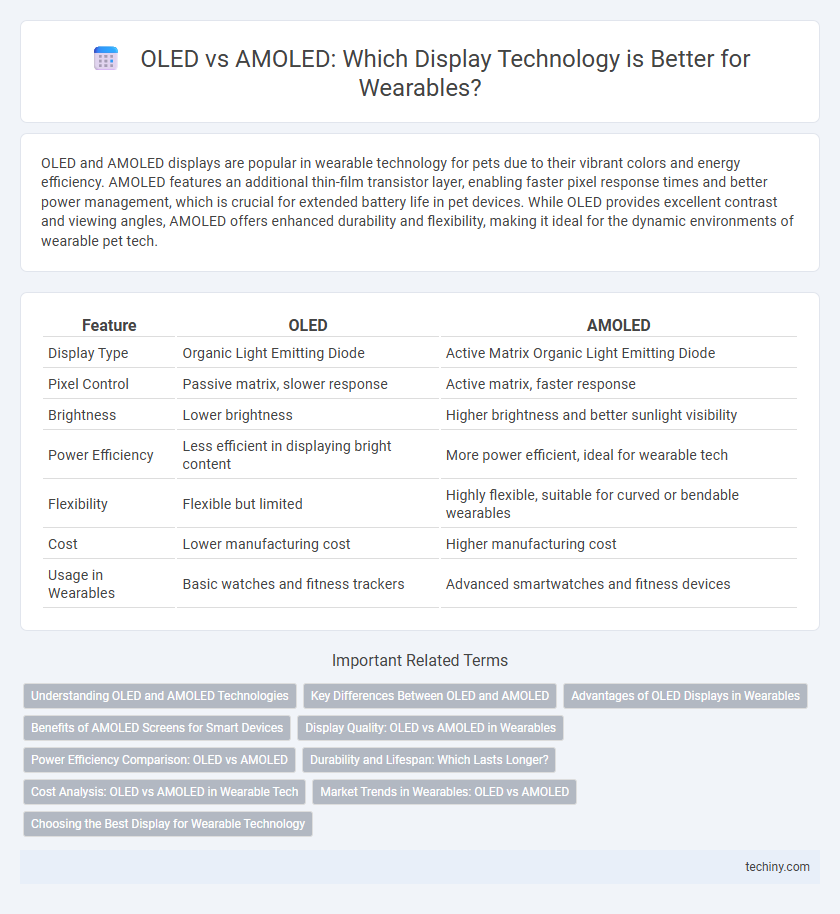OLED and AMOLED displays are popular in wearable technology for pets due to their vibrant colors and energy efficiency. AMOLED features an additional thin-film transistor layer, enabling faster pixel response times and better power management, which is crucial for extended battery life in pet devices. While OLED provides excellent contrast and viewing angles, AMOLED offers enhanced durability and flexibility, making it ideal for the dynamic environments of wearable pet tech.
Table of Comparison
| Feature | OLED | AMOLED |
|---|---|---|
| Display Type | Organic Light Emitting Diode | Active Matrix Organic Light Emitting Diode |
| Pixel Control | Passive matrix, slower response | Active matrix, faster response |
| Brightness | Lower brightness | Higher brightness and better sunlight visibility |
| Power Efficiency | Less efficient in displaying bright content | More power efficient, ideal for wearable tech |
| Flexibility | Flexible but limited | Highly flexible, suitable for curved or bendable wearables |
| Cost | Lower manufacturing cost | Higher manufacturing cost |
| Usage in Wearables | Basic watches and fitness trackers | Advanced smartwatches and fitness devices |
Understanding OLED and AMOLED Technologies
OLED (Organic Light Emitting Diode) technology uses organic materials to emit light when an electric current passes through, enabling thinner, more flexible displays with high contrast and vibrant colors in wearable devices. AMOLED (Active Matrix OLED) incorporates an active matrix of thin-film transistors (TFTs) that control individual pixels more efficiently, offering faster refresh rates, better power management, and enhanced display performance suitable for dynamic wearable screens. Understanding the differences between OLED and AMOLED is crucial for optimizing display quality, battery life, and user experience in modern wearable technology.
Key Differences Between OLED and AMOLED
OLED displays use organic light-emitting diodes that provide excellent color accuracy and energy efficiency by illuminating each pixel individually, whereas AMOLED incorporates an active matrix of thin-film transistors (TFTs) to control pixels more rapidly, enhancing refresh rates and making them ideal for wearable technology. AMOLED screens generally offer higher contrast ratios, faster response times, and better power management compared to standard OLEDs, which benefits the battery life and performance of wearable devices. The integration of AMOLED in wearables supports flexible, thinner displays with superior brightness and durability that are crucial for dynamic environments and extended usage.
Advantages of OLED Displays in Wearables
OLED displays offer superior flexibility and thinner profiles, making them ideal for sleek, lightweight wearable devices. They provide excellent color accuracy and high contrast ratios, enhancing the visual experience essential for smartwatches and fitness trackers. OLED technology also consumes less power during black or dark screen usage, extending battery life in wearable gadgets.
Benefits of AMOLED Screens for Smart Devices
AMOLED screens offer superior contrast ratios and deeper blacks compared to OLED, enhancing visual clarity in wearable technology. Their energy efficiency extends battery life, crucial for smartwatches and fitness trackers where power consumption impacts device usability. Flexible AMOLED displays also enable more ergonomic and lightweight designs, improving user comfort and device durability.
Display Quality: OLED vs AMOLED in Wearables
AMOLED displays in wearable technology offer superior color accuracy and higher contrast ratios compared to traditional OLED screens, enhancing visual clarity in various lighting conditions. The integration of thin-film transistors in AMOLED panels enables faster pixel response times, reducing motion blur during dynamic interactions on smartwatches and fitness trackers. Enhanced power efficiency in AMOLED displays contributes to longer battery life, a critical factor for wearable devices requiring all-day usage.
Power Efficiency Comparison: OLED vs AMOLED
AMOLED displays offer superior power efficiency compared to traditional OLED panels due to their ability to individually control each pixel, reducing energy consumption when rendering darker images. This pixel-level control in AMOLED technology significantly extends battery life in wearable devices by minimizing backlight usage. OLED screens, while efficient, rely on a uniform backlight that can consume more power during high-brightness displays.
Durability and Lifespan: Which Lasts Longer?
OLED displays in wearable technology typically offer exceptional color accuracy but are prone to faster degradation due to organic material wear, resulting in shorter lifespan compared to AMOLED panels. AMOLED screens incorporate an active matrix of thin-film transistors, enhancing energy efficiency and durability by reducing pixel burnout and extending overall device longevity. Studies reveal AMOLED displays can last up to 30-50% longer than standard OLEDs under continuous use, making them a superior choice for durable wearable devices.
Cost Analysis: OLED vs AMOLED in Wearable Tech
OLED panels generally have a lower manufacturing cost due to simpler layer structures, making them more affordable for basic wearable devices. AMOLED technology, with integrated thin-film transistors and active matrix backplanes, offers superior display quality and power efficiency but comes at a higher production cost. Cost analysis in wearable tech reveals that while AMOLED drives premium device pricing, OLED remains a budget-friendly option without compromising core functionality.
Market Trends in Wearables: OLED vs AMOLED
The wearable technology market increasingly favors AMOLED displays due to their superior energy efficiency and higher contrast ratios, essential for extending battery life in smartwatches and fitness trackers. OLED technology, while still prevalent, is gradually being overshadowed by AMOLED's ability to support flexible screens and vibrant colors, driving consumer demand for advanced wearables. Market analyses predict AMOLED adoption in wearables will grow at a CAGR of over 12% through 2028, propelled by innovations in health monitoring and augmented reality applications.
Choosing the Best Display for Wearable Technology
AMOLED displays offer superior contrast ratios and energy efficiency compared to OLED, making them ideal for wearable devices that require extended battery life and vibrant visuals. The self-emissive nature of AMOLED pixels enables deeper blacks and better outdoor visibility, essential for wearables used in various lighting conditions. Choosing AMOLED over OLED enhances user experience by combining high resolution with lower power consumption, crucial for compact, always-on wearable technology.
OLED vs AMOLED Infographic

 techiny.com
techiny.com